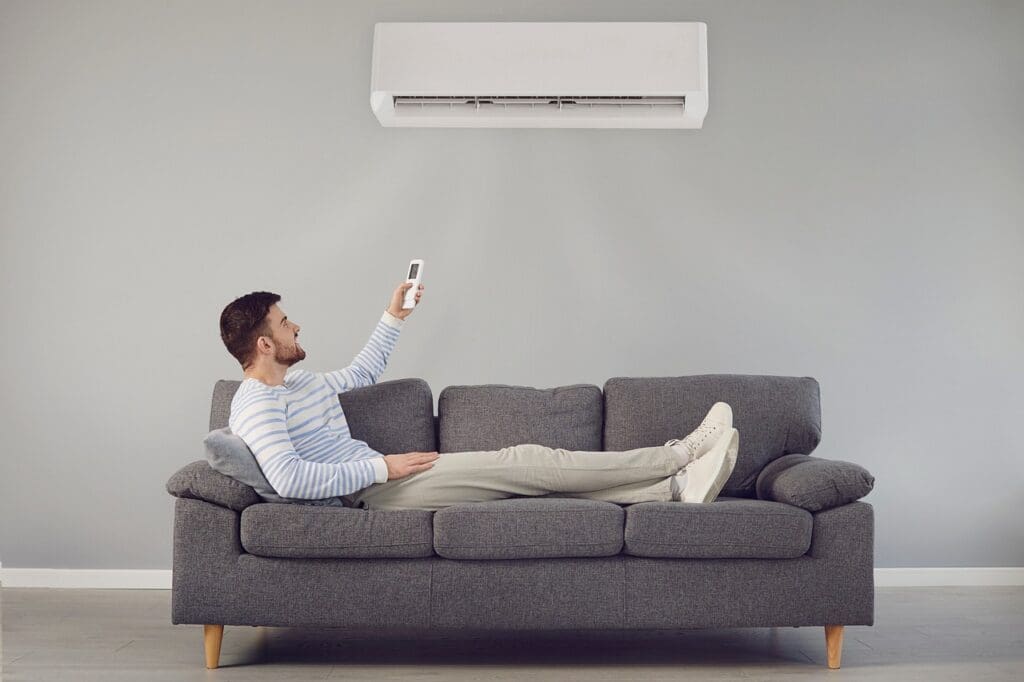
3 to 5-Outlet HEG™ Ducted Air Transfer System
What is a HEG™ Ducted Air Transfer System?
A HEG™ ducted air transfer system, or ATS, is an air redistribution system, whereby air from a living room is gently distributed to other rooms in a house, typically bedrooms, bathrooms or study rooms. The air is transferred via polyester-insulated ducting (sort of like a big, thick and flexible hose) hidden in your roofspace. All you see is an inlet near your existing living room heater, and subtle outlets in the destination rooms. The system is controlled with a remote control, which allows you to turn the fan on/off or change the fan speed. The inlet is a square inlet, and the outlets are round (as shown), except with lath and plaster or wooden ceilings, whereby square outlets are used for technical reasons.

- Image: Air Transfer Transfer Outlet

Transfer air gently around your home on an ongoing basis for increased comfort levels, better air quality and lower power bills. We firmly believe that customers will dramatically lower power bills, increase overnight room temperatures, and have healthier air quality when a good-quality ducted air transfer system, like this one, is combined with an existing living room reverse cycle air conditioner (heat pump) or wood heater.
Adam Hirst – Managing Director of Home Efficiency Group
A good Ducted Air Circulation System will eliminate the need for secondary heating in bedrooms during winter.
Benefits of a good Air Transfer System
The main reasons customers use an air transfer system include:
- Utilise excess heat from your living room heater – typically a heat pump (reverse cycle air conditioner) or wood heater.
- Avoid the need to install heat pumps in other parts of the house – there are exceptions to this, so contact a HEG Residential Energy Consultant on 1300 96 80 60 to discuss, if you are unsure if a second heat pump is required.
- Avoid using expensive-to-run bedrooms heaters – typically panel heaters – which gives you a huge saving on your power bills.
“HEG™ ducted air transfer systems are optimised to work super well with heat pumps (reverse cycle air conditioners) overnight.”
Most systems do not work well with heat pumps (AC’s) or have not been installed or configured to work optimally with heat pumps. HEG™ has specifically designed our air transfer system to work with the gentler heat pump heat.
- Use solar gain from sunny rooms to balance temperatures and pre-warm your home during the day – this is why we recommend to leave the air transfer system on 24/7 during the cooler months. If the warm air is on the air transfer system “circulation path”, then it can be used elsewhere in the home, not only the originating room. A sunny room can be up to 10 degrees warmer than a room at the other end of the house.
- Reduce window condensation in bedrooms – this is done because the rooms are warmer, which “soaks” up more of the moisture within the air molecule rather than depositing it onto a cold surface. Also, air in a bedroom is displaced by the incoming air on a regular basis, which tends to lower the concentration of moisture (from breathing) in that room, thus reducing/removing one of the triggers that causes window condensation.

Professionally-installed HEG Air Transfer System. Square outlets shown in this diagram are only used with lath and plaster ceilings or wooden ceilings.
How should I use the Air Transfer System?
For best results, we suggest leaving it on 24/7 over the cooler winter months – the system does not use very much power, and the benefits are substantial. With the system on semi-permanently, during the day the sun-warmed rooms contribute their heat to the cooler rooms on the non-sunny side of the house, providing a much more balanced temperature throughout. During the evening, or when the living room heater is on, then excess heat from the ceiling of the living room is distributed around the house. Because the air gently cycles around the hose, the returning air takes the chill off the hallways, as a bonus, with less contrast between temperatures throughout the home.
Why HEG™?
There are a few “air transfer kits” being sold via the Internet, but there are are substantial differences between the HEG™ Air Transfer System and a DIY (or a DIY kit that has an installation offer attached). HEG™, or Home Efficiency Group, has been professionally installing ducted air transfer systems, and variants of them (called HEG™ Air Circulation Systems) for over 10 years, so we are experts at providing proven ducting components as well as doing superb installations that minimise noise and maximise efficacy (efficiency and effectiveness). The system has several features that differentiate it from “standard” air transfer kits, aimed at making the system quieter, more efficient and more convenient to use. Some of these features are listed below:
A] PREMIUM FAN: HEG™ has incorporated our top-of-the-line EC (electronically-comutated, also known as “brushless”) fan into the Air Transfer System, as opposed to the typical AC Fans that are commonly used for this application. The HEG™ EC Fan uses substantially less electricity to run, is substantially quieter, has a full 5 year manufacturers replacement warranty (although a labour call-out fee does apply, unless the house), is designed to work with a remote control and has a stepless variable speed fan controller (as opposed to only Low, Medium, High settings).
B] SIMPLY QUIETER: Apart from the super quiet EC fan, “quietness enhancements” include a larger inlet to ensure the in-take of air is done with minimal air disturbance noise, as well as placement of the fan at least 4 metres from the inlet to minimise “referred noise” coming back down. Additionally, fans are hung from the roof bearers, not screwed to your ceiling joists, which means the roof bearers shock-absorb any vibrations.
C] PROFESSIONAL INSTALLATION: We have seen many times where a “good” system has been installed poorly, which then leads to noisy operation, ineffective air flow and, consequently, the system is abandoned and not used. Because HEG™ has installed over 5000 ducted systems, we offer placement of inlets and outlets for optimal effect, as well as hanging the fan and central assembly in a way that minimises vibrations into the home.D] TRIED AND TESTED: There are some ugly systems out there in the market :-). We pride ourselves on having industry-best inlets and outlets to minimise drafts and make the system look aesthetically appealing. An example of this latter point is whereby the outlets for plasterboard-ceiling houses utilise a “full cone-nose diffuser, which diffusers the air into a room at a 5 degree angle for draught-free operation, has a matte-textured “underbelly” for a pleasant visual appeal, and you aren’t able to see into the ducting cavity behind the diffuser.
HEG™ Air Transfer vs HEG™ Air Circulation Systems
It should be noted that there is a difference between the HEG™ Air Transfer System (ATS) and the HEG™ Air Circulation System (ACS). For (a) larger houses that require 6 or more outlets or have larger air volumes to contend with, (b) houses that are experiencing severe window condensation, or (c) those households who wish to optimise efficiencies by accessing the free solar gain from their roof space, then an ACS would be more applicable.
Some of the technical differences between the ATS and ACS system including the need for the ACS to hardwire sensors and controllers, filtered inlets in the living room and roofspace, plus automated motorised dampers (and associated wiring and electrician labour costs). In this case, please contact us and a HEG Residential Energy Consultant will assess your requirements – Tel 1300 968 060, email info@heg.com.au or fill out a web form and we will contact you. Unfortunately, due to incompatible ducting sizes, different configurations, components and controllers, the ATS cannot be upgraded to including the ACS modules (such as the window condensation [ventilation] module or filtered inlet).
What’s the next step to get an ATS installed?
Please call HEG on 1300 96 80 60 (option #1 on the phone system for “Sales”), or fill out our web form and we will contact you. Alternatively, if you wanted to email floorplans or queries, etc, then email us on info@heg.com.au. Please note: a travel fee outside of 30km from Launceston or Hobart applies (unless we can bundle several jobs in the same area together), and roof-off work also attracts a fee as it falls outside of our standard installation inclusions. Also, if a house is particularly long, a “fair use” term applies, whereby we reserve the right to charge for additional ducting and other components that may be required. Installs are subject to a formal quotation.
